User:CDDRDR/Water scarcity
| This is the sandbox page where you will draft your initial Wikipedia contribution.
If you're starting a new article, you can develop it here until it's ready to go live. If you're working on improvements to an existing article, copy only one section at a time of the article to this sandbox to work on, and be sure to use an edit summary linking to the article you copied from. Do not copy over the entire article. You can find additional instructions here. Remember to save your work regularly using the "Publish page" button. (It just means 'save'; it will still be in the sandbox.) You can add bold formatting to your additions to differentiate them from existing content. |
Water Scarcity
[edit]
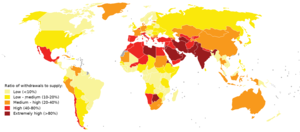
Water scarcity (closely related to water stress or water crisis) is the lack of fresh water resources to meet the standard water demand. Two types of water scarcity have been defined: physical or economic water scarcity. Physical water scarcity is where there is not enough water to meet all demands, including that needed for ecosystems to function effectively. Arid areas (for example Central and West Asia, and North Africa) often suffer from physical water scarcity.[1] On the other hand, economic water scarcity is caused by a lack of investment in infrastructure or technology to draw water from rivers, aquifers, or other water sources, or insufficient human capacity to satisfy the demand for water. Much of Sub-Saharan Africa is characterized by economic water scarcity.[2]: 11
The essence of global water scarcity is the geographic and temporal mismatch between fresh water demand and availability.[3][4] At the global level and on an annual basis, enough freshwater is available to meet such demand, but spatial and temporal variations of water demand and availability are large, leading to physical water scarcity in several parts of the world during specific times of the year.[5] The main driving forces for the rising global demand for water are the increasing world population, improving living standards, changing consumption patterns (for example a dietary shift toward more animal products),[6] and expansion of irrigated agriculture.[7][8] Climate change (including droughts or floods), deforestation, increased water pollution and wasteful use of water can also cause insufficient water supply.[9] Scarcity varies over time as a result of natural hydrological variability, but varies even more so as a function of prevailing economic policy, planning and management approaches. Scarcity can be expected to intensify with most forms of economic development, but, if correctly identified, many of its causes can be predicted, avoided or mitigated.[10]
Water scarcity assessments need to incorporate information on green water (soil moisture), water quality, environmental flow requirements, globalization, and virtual water trade.[6] There is a need for collaboration between hydrological, water quality, aquatic ecosystem science and social science communities in water scarcity assessment.[6] "Water stress" has been used as parameter to measure water scarcity, for example in the context of Sustainable Development Goal 6.[11] Two-thirds of the global population (4 billion people) live under conditions of severe water scarcity at least one month of the year.[5][12] Half a billion people in the world face severe water scarcity all year round.[5][6] Half of the world's largest cities experience water scarcity.[12]
Options for reducing water scarcity include: supply and demand side management, cooperation between countries, water conservation (including prevention of water pollution), expanding sources of usable water (through wastewater reuse or desalination) and virtual water trade.
Definitions
[edit]There are several definitions of "water scarcity", "water stress", and "water risk" provided in the literature, and therefore a harmonization has been proposed by the CEO Water Mandate in 2014.[13]: 2 In their discussion paper they state that these three terms should not be used interchangeably.[13]: 3
Water scarcity
[edit]"Water scarcity" has been defined as the "volumetric abundance, or lack thereof, of freshwater resources" and it is thought to be "human-driven".[13]: 4 This can also be called "physical water scarcity".[2] Environmental water requirements are sometimes included in water scarcity determinations but the approach to this varies from one organization to another.[13]: 4
Water stress
[edit]Some organizations define "water stress" as a broader concept. Under that definition, it would include aspects of water availability, water quality and the accessibility of water. The latter is related to existing infrastructure and whether customers can afford to pay for the water.[13]: 4 This is termed by others as "economic water scarcity".[2]
FAO defines water stress as the symptoms of water scarcity. Such symptoms could be water restrictions, water conflicts between users, competition for water and declining standards of service.[10] This is measured with a range of Water Stress Indices. Additionally, WorldWater maintains an updated map of (Chronological) global water conflict. [14]
Another definition for water stress is as follows: "Water stress refers to the impact of high water use (either withdrawals or consumption) relative to water availability."[15] Water stress is therefore regarded as a "demand-driven scarcity".
Related concepts
[edit]Water risk
[edit]"Water risk" refers to the "possibility of an entity experiencing a water-related challenge (e.g., water scarcity, water stress, flooding, infrastructure decay, drought)".[13]: 4 Water risk is inversely related to water security, meaning that as water risk increases, water security decreases. Water risk is complex and multidimensional. It includes risks from natural disasters such as flooding and drought, which can lead to infrastructure failure and worsen hunger.[16] When these risks are realized, they result in water scarcity.
The potential economic effects of water risk are significant. Entire industries, such as the food and beverage, agriculture, oil and gas, utilities, semiconductor and industries, are threatened by water risk. Agriculture uses 69% of global freshwater, making the industry extremely vulnerable to water stress.[17] The financial sector is becoming more aware of the potential impacts of water risk and the need for its proper management. By 2025, $145 trillion in assets under management are expected to be exposed to water risk.[18]
To help mitigate water risk, companies can develop water risk management plans.[16] These can then be used by financial markets to measure company environmental, social and governance (ESG) performance and identify leaders in water risk management.[19][17] The World Resources Institute has also developed an online water data platform named Aqueduct for risk assessment and water management. China Water Risk is a nonprofit dedicated to understanding and managing water risk in China. The World Wildlife Fund has a Water Risk Filter that helps companies assess and respond to water risk with scenarios for 2030 and 2050.[20] The World Wildlife Fund has also partnered with DWS, which provides additional business solutions to water risk including water-centric investment funds.[21]
Water security
[edit]The aim of water security is to make the most of water's benefits for humans and ecosystems. The second aim is to limit the risks of destructive impacts of water to an acceptable level.[22][23] These risks include for example too much water (flood), too little water (drought and water scarcity) or poor quality (polluted) water.[22] People who live with a high level of water security always have access to "an acceptable quantity and quality of water for health, livelihoods and production".[23] For example, access to water, sanitation and hygiene services is one part of water security.[24] Some organizations use the term water security more narrowly for water supply aspects only.
Types
[edit]Two types of water scarcity have been defined: physical and economic water scarcity. These terms were first defined in a wide-ranging 2007 study on the use of water in agriculture over the previous 50 years of practitioners, researchers and policymakers, overseen by the International Water Management Institute, with the aim of finding out if the world had sufficient water resources to produce food for the growing population in the future.[2][10]
Physical/Biophysical water scarcity
[edit]Physical/Biophysical water scarcity is where there is not enough water to meet all demands, including that needed for ecosystems to function effectively. Arid regions frequently suffer from physical water scarcity. It also occurs where water seems abundant but where resources are over-committed, such as when there is overdevelopment of hydraulic infrastructure, often for irrigation or energy generation. Symptoms of physical water scarcity include severe environmental degradation, such as water pollution, and declining groundwater and water allocations that favor some groups over others.[7][10]
Physical water scarcity results from inadequate natural water resources to supply a region's demand, and economic water scarcity results from poor management of the sufficient available water resources. According to the United Nations Development Programme, the latter is found more often to be the cause of countries or regions experiencing water scarcity, as most countries or regions have enough water to meet household, industrial, agricultural, and environmental needs, but lack the means to provide it in an accessible manner.[25] Around one-fifth of the world's population currently live in regions affected by physical water scarcity.[25]
Water is physically scarce in densely populated arid areas (for example Central and West Asia, and North Africa), with projected availabilities of less than 1000 cubic meters per capita per year.[1] A study in 2007 found that more than 1.2 billion people live in areas of physical water scarcity.[26] This water scarcity relates to water available for food production, rather than for drinking water which is a much smaller amount.[1][27]
Economic water scarcity
[edit]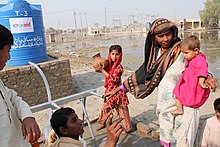
Economic water scarcity is caused by a lack of investment in infrastructure or technology to draw water from rivers, aquifers, or other water sources, or insufficient human capacity to satisfy the demand for water. One-quarter of the world's population is affected by economic water scarcity. Economic water scarcity includes a lack of infrastructure, causing the people without reliable access to water to have to travel long distances to fetch water, which is often contaminated from rivers for domestic and agricultural uses (irrigation).
Much of Sub-Saharan Africa is characterized by economic water scarcity.[2]: 11 Developing water infrastructure there could therefore help to reduce poverty. Investing in water retention and irrigation infrastructure would also help to increase food production, especially in developing countries that largely rely on low-yield agriculture.[28] Being able to provide a community with water that is adequate for consumption would also greatly benefit the people's health.[29] Overcoming this type of scarcity, however, can require more than just new infrastructure; it requires socio-economic and socio-political types of intervention that address poverty and socio-inequality but because there is a lack of funding, much planning must come into play.[30]
Although much emphasis is put on improving water sources for drinking and domestic purposes, we know that much more water is used for other uses such as bathing, laundry, livestock and cleaning than for drinking and cooking alone.[29] This observation suggests that putting too much emphasis on drinking water needs addresses an insignificant part of the problem of water resources and therefore limits the range of solutions available.[29]
Assessments and indicators
[edit]Simple indicators
[edit]Relatively simply indicators include: the water use to availability ratio (or criticality ratio), physical and economic water scarcity—The IWMI Indicator, water poverty index.[6]
"Water stress" has been used as parameter to measure water scarcity, for example in the context of Sustainable Development Goal 6.[11] In this context, a report by FAO in 2018 has defined water stress as: "the ratio between total freshwater withdrawn (TFWW) by all major sectors and total renewable freshwater resources (TRWR), after taking into account environmental flow requirements (EFR)". This means that the value for TFWW is divided by the difference between TRWR minus EFR.[31]: xii Environmental flows are water flows required to sustain freshwater and estuarine ecosystems. Previously, a definition used for Millennium Development Goal 7, target 7.A was simply the proportion of total water resources used, without taking into consideration EFR.[31]: 28 With this definition, water stress is defined by the following categories: <10% is low stress; 10-20% is low-to-medium; 20-40% medium-to-high; 40-80% high; >80% extremely high.[32]
Indicators are used to measure the extent of the water scarcity.[33] One approach to measuring water scarcity is to calculate the amount of annual water resources available per person. For example, according to the "Falkenmark Water Stress Indicator" (developed by Malin Falkenmark), a country or region is said to experience "water stress" when annual water supplies drop below 1,700 cubic meters per person per year.[34] At levels between 1,700 and 1,000 cubic meters per person per year, periodic or limited water shortages can be expected. When water supplies drop below 1,000 cubic meters per person per year, the country faces "water scarcity". However, the Falkenmark Water Stress Indicator does not help to explain the true nature of water scarcity.[1]
Renewable freshwater resources
[edit]Renewable freshwater supply is a metric often used in conjunction when evaluating water scarcity. This metric is informative because it can describe the total available water resource each country contains. By knowing the total available water source, an idea can be gained about whether a country is prone to experiencing physical water scarcity.[35] This metric has its faults in that it is an average; precipitation delivers water unevenly across the planet each year and annual renewable water resources vary from year to year. This metric also does not describe the accessibility of water to individuals, households, industries, or the government. Lastly, as this metric is a description of a whole country, it does not accurately portray whether a country is experiencing water scarcity. For example, Canada and Brazil both have very high levels of available water supply but still, experience various water-related problems.[35] Also, some tropical countries in Asia and Africa have low availability of freshwater resources.
More sophisticated indicators
[edit]Water scarcity assessments need to incorporate information on green water (soil moisture), water quality, environmental flow requirements, globalization, and virtual water trade.[6] Since the beginning of the 2000s, water scarcity assessments have applied more sophisticated models which are supported with spatial analytical tools. They include: Green-blue water scarcity, water footprint-based water scarcity assessment, cumulative abstraction to demand ratio—considering temporal variations, LCA-based water stress indicators (life cycle assessments), integrated water quantity–quality environment flow in the water scarcity assessment.[6]
Overall, there is a need for collaboration between hydrological, water quality, aquatic ecosystem science and social science communities in water scarcity assessment.[6]
Available water
[edit]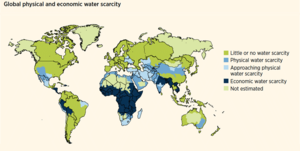
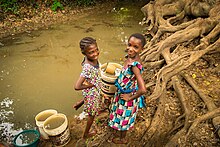
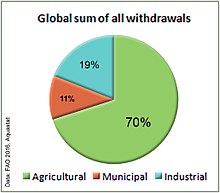

The United Nations (UN) estimates that, of 1.4 billion cubic kilometers (1 quadrillion acre-feet) of water on Earth, just 200,000 cubic kilometers (162.1 billion acre-feet) represent freshwater available for human consumption. A mere 0.014% of all water on Earth is both fresh and easily accessible.[36] Of the remaining water, 97% is saline, and a little less than 3% is difficult to access. The fresh water available to us on the planet is around 1% of the total water on earth.[37] The total amount of easily accessible freshwater on Earth, in the form of surface water (rivers and lakes) or groundwater (in aquifers, for example), is 14,000 cubic kilometers (nearly 3359 cubic miles). Of this total amount, 'just' 5,000 cubic kilometers are being used and reused by humanity. Technically, there is a sufficient amount of freshwater on a global scale. Hence, in theory, there is more than enough freshwater available to meet the demands of the current world population of more than 7 billion people, and even support population growth to 9 billion or more. Due to the unequal geographical distribution and especially the unequal consumption of water, however, it is a scarce resource in some parts of the world and for some parts of the population.
Apart from the conventional surface water sources of freshwater such as rivers and lakes, other resources of freshwater such as groundwater and glaciers have become more developed sources of freshwater, becoming the main source of clean water. Groundwater is water that has pooled below the surface of the Earth and can provide a usable quantity of water through springs or wells. These areas where groundwater is collected are also known as aquifers. More and more of these sources are being drawn upon as conventional sources' usability decreases due to factors such as pollution or disappearance due to climate changes. Human population growth is a significant contributing factor in the increasing use of these types of water resources.[35]
Scale
[edit]Current estimates
[edit]Water scarcity was listed in 2019 by the World Economic Forum as one of the largest global risks in terms of potential impact over the next decade.[38] It is manifested by partial or no satisfaction of expressed demand, economic competition for water quantity or quality, disputes between users, irreversible depletion of groundwater, and negative impacts on the environment.[10]
Two-thirds of the global population (4 billion people) live under conditions of severe water scarcity at least one month of the year.[5][12] Half a billion people in the world face severe water scarcity all year round.[5] Half of the world's largest cities experience water scarcity.[12] A study in 2016 calculated that globally, the population under water scarcity increased from 0.24 billion (14% of global population) in the 1900s to 3.8 billion (58%) in the 2000s.[15] This study analyzed water scarcity using the fundamental concepts of shortage (impacts due to low availability per capita) and stress (impacts due to high consumption relative to availability).
Future predictions
[edit]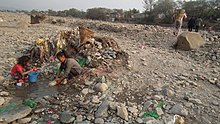
With the increase in global temperatures and in an increase in water demand, six out of ten people are at risk of being water-stressed. The drying out of wetlands globally, at around 67%, was a direct cause of a large number of people at risk of water stress. As the global demand for water increases and as climate temperatures rise, it is estimated that two-thirds of the population, in 2025, will live under water stress.[39][37]: 191 As water becomes scarce, people cannot get enough to drink, wash, or feed crops.[39]
According to a projection by the United Nations, by the year 2040, there can be about 4.5 billion people affected by a water crisis (or water scarcity). Additionally, with the increase in population, there will be a demand for food, for the food output to match the population growth, there would be an increased demand for water to irrigate crops.[40] Increasing the demand for water as well as increasing the population results in a water crisis where there is not enough water to share in healthy levels. The crises are not only due to quantity but quality also matters.
A study found that of ~39 million groundwater wells 6-20% are at high risk of running dry if local groundwater levels decline by a few meters, or – as with many areas and possibly more than half of major aquifers[41] – continue to decline.[42][43]
Impacts
[edit]There are several impacts of water scarcity:
- Food security in the Middle East and North Africa Region [44][45]
- Inadequate access to safe drinking water for about 885 million people[46]
- Groundwater overdrafting (excessive use) leading to diminished agricultural yields[47]
- Overuse and pollution of water resources harming ecosystems and biodiversity
- Regional conflicts over scarce water resources sometimes resulting in warfare.[48]
Symptoms of water scarcity can be serious restrictions on use, growing conflict between users and competition for water, declining standards of reliability and service, harvest failures and food insecurity.[10]
Environment
[edit]Abstraction of water for domestic, food and industrial uses has major impacts on ecosystems in many parts of the world. This can apply even to regions not considered "water scarce".[1] Water scarcity has many negative impacts on the environment, such as adverse effects on lakes, rivers, ponds, wetlands and other fresh water resources. The resulting water overuse that is related to water scarcity, often located in areas of irrigation agriculture, harms the environment in several ways including increased salinity, nutrient pollution, and the loss of floodplains and wetlands.[25][49] Furthermore, water scarcity makes flow management in the rehabilitation of urban streams problematic.[50]
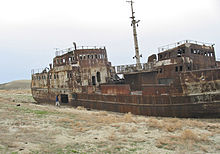
Through the last hundred years, more than half of the Earth's wetlands have been destroyed and have disappeared.[9] These wetlands are important not only because they are the habitats of numerous inhabitants such as mammals, birds, fish, amphibians, and invertebrates, but they support the growing of rice and other food crops as well as provide water filtration and protection from storms and flooding. Freshwater lakes such as the Aral Sea in central Asia have also suffered. Once the fourth largest freshwater lake, it has lost more than 58,000 square km of area and vastly increased in salt concentration over the span of three decades.[9]
Subsidence, or the gradual sinking of landforms, is another result of water scarcity. The U.S. Geological Survey estimates that subsidence has affected more than 17,000 square miles in 45 U.S. states, 80 percent of it due to groundwater usage.[51]
Vegetation and wildlife are fundamentally dependent upon adequate freshwater resources. Marshes, bogs and riparian zones are more obviously dependent upon sustainable water supply, but forests and other upland ecosystems are equally at risk of significant productivity changes as water availability is diminished. In the case of wetlands, considerable area has been simply taken from wildlife use to feed and house the expanding human population. But other areas have suffered reduced productivity from gradual diminishing of freshwater inflow, as upstream sources are diverted for human use.
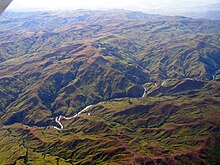
Water supply shortages
[edit]Water is the underlying tenuous balance of safe water supply, but controllable factors such as the management and distribution of the water supply itself contribute to further scarcity. A 2006 United Nations report focuses on issues of governance as the core of the water crisis, saying "There is enough water for everyone" and "Water insufficiency is often due to mismanagement, corruption, lack of appropriate institutions, bureaucratic inertia and a shortage of investment in both human capacity and physical infrastructure".[52]
It has also been claimed, primarily by economists, that the water situation has occurred because of a lack of property rights, government regulations and subsidies in the water sector, causing prices to be too low and consumption too high, making a point for water privatization.[53][54][55]
The clean water crisis is an emerging global crisis that affects approximately 785 million people around the world.[56] 1.1 billion people lack access to water and 2.7 billion experience water scarcity at least one month in a year. 2.4 billion people suffer from the contamination of water and poor sanitation. Contamination of water can lead to deadly diarrheal diseases such as cholera and typhoid fever, and other waterborne diseases causing 80% of illnesses around the world.[57]
Causes and contributing factors
[edit]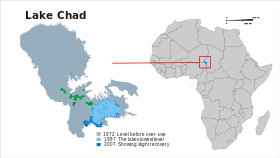
Population growth
[edit]Around fifty years ago, the common perception was that water was an infinite resource. At that time, there were fewer than half the current number of people on the planet. People were not as wealthy as today, consumed fewer calories and ate less meat, so less water was needed to produce their food. They required a third of the volume of water we presently take from rivers. Today, the competition for water resources is much more intense. This is because there are now seven billion people on the planet, their consumption of water-thirsty meat is rising, and there is increasing competition for water from industry, urbanization biofuel crops, and water reliant food items. In the future, even more water will be needed to produce food because the Earth's population is forecast to rise to 9 billion by 2050.[59]
In 2000, the world population was 6.2 billion. The UN estimates that, by 2050, there will be an additional 3.5 billion people with most of the growth in developing countries that already suffer water stress.[60] Thus, water demand will increase unless there are corresponding increases in water conservation and recycling of this vital resource.[61] In building on the data presented here by the UN, the World Bank[62] goes on to explain that access to water for producing food will be one of the main challenges in the decades to come. Access to water will need to be balanced with the importance of managing water itself in a sustainable way while taking into account the impact of climate change, and other environmental and social variables.[63]
In 60% of European cities with more than 100,000 people, groundwater is being used at a faster rate than it can be replenished.[64]
Over-exploitation of groundwater
[edit]Due to the expanding human population, competition for water is growing such that many of the world's major aquifers are becoming depleted. This is due both to direct human consumption as well as agricultural irrigation by groundwater. Millions of pumps of all sizes are currently extracting groundwater throughout the world. Irrigation in dry areas such as northern China, Nepal and India is supplied by groundwater and is being extracted at an unsustainable rate. Cities that have experienced aquifer drops between 10 and 50 meters include Mexico City, Bangkok, Beijing, Madras and Shanghai.[65]
Until recent history, groundwater was not a highly utilized resource. In the 1960s, more and more groundwater aquifers developed.[66] Changes in knowledge, technology and funding have allowed for focused development into abstracting water from groundwater resources away from surface water resources. These changes allowed for progress in society such as the "agricultural groundwater revolution", expanding the irrigation sector allowing for increased food production and development in rural areas.[67] Groundwater supplies nearly half of all drinking water in the world.[68] The large volumes of water stored underground in most aquifers have a considerable buffer capacity allowing for water to be withdrawn during periods of drought or little rainfall.[35] This is crucial for people that live in regions that cannot depend on precipitation or surface water as a supply alone, instead providing reliable access to water all year round. As of 2010, the world's aggregated groundwater abstraction is estimated at approximately 1,000 km3 per year, with 67% used for irrigation, 22% used for domestic purposes and 11% used for industrial purposes.[35] The top ten major consumers of abstracted water (India, China, United States of America, Pakistan, Iran, Bangladesh, Mexico, Saudi Arabia, Indonesia, and Italy) make up 72% of all abstracted water use worldwide.[35]
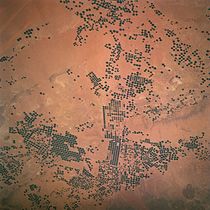
Although groundwater sources are quite prevalent, one major area of concern is the renewal rate or recharge rate of some groundwater sources. Extracting from groundwater sources that are non-renewable could lead to exhaustion if not properly monitored and managed.[70] Another concern of increased groundwater usage is the diminished water quality of the source over time. Reduction of natural outflows, decreasing stored volumes, declining water levels and water degradation are commonly observed in groundwater systems.[35] Groundwater depletion may result in many negative effects such as increased cost of groundwater pumping, induced salinity and other water quality changes, land subsidence, degraded springs and reduced baseflows.
Expansion of agricultural and industrial users
[edit]Scarcity as a result of consumption is caused primarily by the extensive use of water in agriculture/livestock breeding and industry. People in developed countries generally use about 10 times more water daily than those in developing countries.[71] A large part of this is indirect use in water-intensive agricultural and industrial production processes of consumer goods, such as fruit, oilseed crops and cotton. Because many of these production chains have been globalized, a lot of water in developing countries is being used and polluted in order to produce goods destined for consumption in developed countries.[72]
Surface irrigation, or furrow/flood-system irrigation is among the more common practices globally and is heavily utilized by the Global South because it incurs minimal expenditure and does not require advanced technologies, or extensive specialization. Flood-System irrigation is highly prone to Surface runoff resulting from Waterlogged soil; with runoff wasting an average of 55% of freshwater resources used. The increased soil salinization over time manifests as inconstancy in cultivation practices and reduced quality and quantity of agricultural yields.
Many aquifers have been over-pumped and are not recharging quickly. Although the total fresh water supply is not used up, much has become polluted, salted, unsuitable or otherwise unavailable for drinking, industry and agriculture. To avoid a global water crisis, farmers will have to strive to increase productivity to meet growing demands for food, while industry and cities find ways to use water more efficiently.[73]
Business activity ranging from industrialization to services such as tourism and entertainment continues to expand rapidly. This expansion requires increased water services including both supply and sanitation, which can lead to more pressure on water resources and natural ecosystem. The approximate 50% growth in world energy use by 2040 will also increase the need for efficient water use,[74] and may shift some irrigation water sources towards industrial use, as thermal power generation uses water for steam generation and cooling.[citation needed]
Water pollution
[edit]
Water pollution (or aquatic pollution) is the contamination of water bodies, with a negative impact on their uses.[75]: 6 It is usually a result of human activities. Water bodies include lakes, rivers, oceans, aquifers, reservoirs and groundwater. Water pollution results when contaminants mix with these water bodies. Contaminants can come from one of four main sources. These are sewage discharges, industrial activities, agricultural activities, and urban runoff including stormwater.[76] Water pollution may affect either surface water or groundwater. This form of pollution can lead to many problems. One is the degradation of aquatic ecosystems. Another is spreading water-borne diseases when people use polluted water for drinking or irrigation.[77] Water pollution also reduces the ecosystem services such as drinking water provided by the water resource.
Sources of water pollution are either point sources or non-point sources.[78] Point sources have one identifiable cause, such as a storm drain, a wastewater treatment plant, or an oil spill. Non-point sources are more diffuse. An example is agricultural runoff.[79] Pollution is the result of the cumulative effect over time. Pollution may take many forms. One would is toxic substances such as oil, metals, plastics, pesticides, persistent organic pollutants, and industrial waste products. Another is stressful conditions such as changes of pH, hypoxia or anoxia, increased temperatures, excessive turbidity, or changes of salinity). The introduction of pathogenic organisms is another. Contaminants may include organic and inorganic substances. A common cause of thermal pollution is the use of water as a coolant by power plants and industrial manufacturers.
Additional sources of water pollution include Chemical pollution, Nutrient pollution, Oxygen depletion pollution (see Hypoxia-Aquatic), Microbiological pollution, and Suspended Matter pollution.
Climate change
[edit]Climate change could have significant impacts on water resources around the world because of the close connections between the climate and hydrological cycle. Rising temperatures will increase evaporation and lead to increases in precipitation, though there will be regional variations in rainfall. Both droughts and floods may become more frequent in different regions at different times, and dramatic changes in snowfall and snow melt are expected in mountainous areas. Higher temperatures will also affect water quality in ways that are not well understood. Possible impacts include increased eutrophication. Climate change could also mean an increase in demand for farm irrigation, garden sprinklers, and perhaps even swimming pools. There is now ample evidence that increased hydrologic variability and change in climate has and will continue have a profound impact on the water sector through the hydrologic cycle, water availability, water demand, and water allocation at the global, regional, basin, and local levels.[80]
The United Nations' FAO states that by 2025, 1.9 billion people will live in countries or regions with absolute water scarcity, and two-thirds of the world population could be under stress conditions.[81] The World Bank adds that climate change could profoundly alter future patterns of both water availability and use, thereby increasing levels of water stress and insecurity, both at the global scale and in sectors that depend on water.[82]
Overall, the effects of changes in population on water scarcity were found to be about four times more important than changes in water availability as a result of long-term climate change.[39]
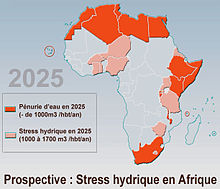
Glaciers
[edit]About 2% of Earth's water is frozen freshwater found in glaciers. Glaciers provide freshwater in the form meltwater, or freshwater melted from snow or ice, that supply streams or springs as temperatures rise. This water is used by locals for a number of reasons like agriculture, livestock, and hydropower.[84] This is beneficial in helping reduce water scarcity as more water is available to a select number of people. It has been projected that total glaciers worldwide will be 60% of what they are now, in the year 2100.[84] The main reason for the melting of these glaciers is climate change. Glaciers reflect sunlight from the sun back into space providing a decrease in temperatures worldwide. This process is called albedo and without the glaciers reflecting sunlight, temperatures would slowly begin to rise.[85] As temperatures rise, glaciers will melt quicker overall reducing the total amount of sunlight being reflected worldwide. Melting glaciers, over a long period of time, begin receding and will be difficult to recover once seasonal changes occur. Glacier's losing mass may decrease their annual run-off, coupled with receding glaciers, which will change the availability of water in many cold regions of the world. About a third of glaciers may experience a 10% run-off reduction in some seasons.[86]
In the Himalayas, retreating glaciers could reduce summer water flows by up to two-thirds. In the Ganges area, this would cause a water shortage for 500 million people.[87] Climate change impacts potable water in the Hindu Kush Himalaya (HKH) area, where around 1.4 billion people are dependent on the five main rivers of Himalaya mountains.[88] Although the impact will vary from place to place, it is predicted that the amount of meltwater will initially increase due to retreating glaciers and then gradually decrease because of reducing in glacier mass.[89] In those areas where the amount of available water decreases, climate change makes it difficult to improve access to safe drinkable water.[90] HKH area faces rapid urbanization causing a severe shortage of water and pressure on water resources. Rural areas will also suffer because of a lack of effective water management infrastructure and limited access to drinking water. More people will migrate because of the scarcity of drinking water. This situation will increase inequality by leaving the poor behind that cause higher mortality and suicide rate, and accelerate further urbanization.[91]
International Paradigms
[edit]Water is one of the most crucial elements in developmental planning; efforts to develop, conserve, utilize and manage water resources have to be guided by national perspectives.[92] A review in 2006 stated that "It is surprisingly difficult to determine whether water is truly scarce in the physical sense at a global scale (a supply problem) or whether it is available but should be used better (a demand problem)".[1]
Supply and demand side management
[edit]The International Resource Panel of the UN states that governments have tended to invest heavily in largely inefficient solutions: mega-projects like dams, canals, aqueducts, pipelines and water reservoirs, which are generally neither environmentally sustainable nor economically viable.[93] The most cost-effective way of decoupling water use from economic growth, according to the scientific panel, is for governments to create holistic water management plans that take into account the entire water cycle: from source to distribution, economic use, treatment, recycling, reuse and return to the environment.
In general, there is enough water on an annual and global scale, but the issue is more of a temporal and spatial variation. Therefore, reservoirs and pipelines are needed to address the temporal and spatial variations. It is necessary to have a well-planned infrastructure with demand side management. Both supply-side and demand-side management have advantages and disadvantages.[citation needed]
Co-operation between countries
[edit]Lack of cooperation may give rise to regional water conflicts in many parts of the world, specially in developing countries, largely because of the disputes regarding the availability, use and management of water.[48] For example, the dispute between Egypt and Ethiopia over the Grand Ethiopian Renaissance Dam has escalated in 2020.[94][95] Egypt sees the dam as an existential threat, fearing that the dam will reduce the amount of water it receives from the Nile.[96]
Human right to water
[edit]The 1997 United Nations Convention on the Law of Non-Navigational Uses of International Watercourses articles; V, VII, VIII, and, IX, specify general principles and frameworks regarding Water utilization & protocols internationally: V. Equitable and Reasonable Utilization & Participation; VII. Obligation to Cause No Significant Harm; VIII. General Obligation to Cooperate; and IX. Regular Exchange of Data and Information; respectively. [97]
The United Nations Committee on Economic, Social and Cultural Rights established a foundation of five core attributes for water security. They declare that the human right to water entitles everyone to sufficient, safe, acceptable, physically accessible, and affordable water for personal and domestic use.[25] UN-Water defines Sufficient, Safe, Acceptable, Physically Acceptable, and Affordable as follows:
- “Sufficient”: The water supply for each person must be sufficient and continuous for personal and domestic uses. These used ordinarily include drinking, personal sanitation, washing of cloths, food preparation, personal household hygiene.
- “Safe”: The water required for each personal or domestic use must be safe, therefore free from microorganisms, chemical substances and radiological hazards that constitute a threat to a person’s health. Measures of drinking-water safety are usually defined by national and/or local standards for drinking-water quality.
- “Acceptable”: Water should be of an acceptable colour [sic], odour [sic], and taste for each personal or domestic use. All water facilities and services must be culturally appropriate and sensitive to gender, lifecycle [sic] and privacy requirements.
- “Physically Accessible”: Everyone has the right to a water and sanitation service that is physically accessible within, or in the immediate vicinity of the household, educational institution, workplace [sic] or health institution.
- “Affordable”: Water, and water for facilities and services, must be affordable for all. [98]
Water conservation
[edit]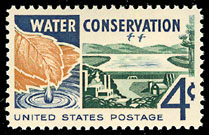
Water conservation aims to sustainably manage the natural resource of fresh water, protect the hydrosphere, and meet current and future human demand. Water conservation makes it possible to avoid water scarcity. It covers all the policies, strategies and activities to reach these aims. Population, household size and growth and affluence all affect how much water is used.
Climate change and other factors have increased pressure on natural water resources. This is especially the case in manufacturing and agricultural irrigation.[99] Many countries have successfully implemented policies to conserve water conservation.[100] There are several key activities to conserve water. One is beneficial reduction in water loss, use and waste of resources.[101] Another is avoiding any damage to water quality. A third is improving water management practices that reduce the use or enhance the beneficial use of water.[102][103]
Countermeasures & Potential Solutions
[edit]Expanding sources of usable water
[edit]There are several artificial sources of fresh water. One is treated wastewater (reclaimed water). Another is atmospheric water generators.[104][105][106] Desalinated seawater is another important source. It is important to consider the economic and environmental side effects of these technologies.[107]
Wastewater treatment and reclaimed water
[edit]Water reclamation is the process of converting municipal wastewater or sewage and industrial wastewater into water that can be reused for a variety of purposes . It is also called wastewater reuse, water reuse or water recycling. There are many types of reuse. It is possible to reuse water in this way in cities or for irrigation in agriculture. Other types of reuse are environmental reuse, industrial reuse, and reuse for drinking water, whether planned or not. Reuse may include irrigation of gardens and agricultural fields or replenishing surface water and groundwater. This latter is also known as groundwater recharge. Reused water also serve various needs in residences such as toilet flushing, businesses, and industry. It is possible to treat wastewater to reach drinking water standards. Injecting reclaimed water into the water supply distribution system is known as direct potable reuse. Drinking reclaimed water is not typical.[108] Reusing treated municipal wastewater for irrigation is a long-established practice. This is especially so in arid countries. Reusing wastewater as part of sustainable water management allows water to remain an alternative water source for human activities. This can reduce scarcity. It also eases pressures on groundwater and other natural water bodies.[109]
Wastewater treatment is a process which removes and eliminates contaminants from wastewater. It thus converts it into an effluent that can be returned to the water cycle. Once back in the water cycle, the effluent creates an acceptable impact on the environment. It is also possible to reuse it. This process is called water reclamation.[110] The treatment process takes place in a wastewater treatment plant. There are several kinds of wastewater which are treated at the appropriate type of wastewater treatment plant. For domestic wastewater the treatment plant is called a Sewage Treatment. Municipal wastewater or sewage are other names for domestic wastewater. For industrial wastewater, treatment takes place in a separate Industrial wastewater treatment, or in a sewage treatment plant. In the latter case it usually follows pre-treatment. Further types of wastewater treatment plants include Agricultural wastewater treatment and leachate treatment plants.
Desalination
[edit]Desalination is a process that removes mineral components from saline water. More generally, desalination is the removal of salts and minerals from a substance.[111] One example is soil desalination. This is important for agriculture. It is possible to desalinate saltwater, especially sea water, to produce water for human consumption or irrigation. The by-product of the desalination process is brine.[112] Many seagoing ships and submarines use desalination. Modern interest in desalination mostly focuses on cost-effective provision of fresh water for human use. Along with recycled wastewater, it is one of the few water resources independent of rainfall.[113]
Virtual water trade
[edit]The virtual water trade is the hidden flow of water in food or other commodities that are traded from one place to another.[114] Other terms for it are embedded or embodied water. The virtual water trade is the idea that virtual water is exchanged along with goods and services. This idea provides a new, amplified perspective on water problems. It balances different perspectives, basic conditions, and interests. This concept makes it possible to distinguish between global, regional, and local levels and their linkages. However, the use of virtual water estimates may offer no guidance for policymakers seeking to ensure they are meeting environmental objectives.
For example, cereal grains have been major carriers of virtual water in countries where water resources are scarce. So cereal imports can compensate for local water deficits.[115] However, low-income countries may not be able to afford such imports in the future. This could lead to food insecurity and starvation.
Technological innovation
[edit]Increased infrastructural projects and technologies are being implemented to counter water scarcity issues, from conservation advancement designed to prevent Seepage and waste and improve Catchment systems through Hydrological developments. Sensory technology is being utilized in countries like Singapore to detect leakages in sewerage and freshwater pipe systems which can be responsible for up to 33% of freshwater waste[116] in urban cities. Improved Water purification and filtration systems help to preserve and increase both healthy quantities of water, and ultimately assist with returning improved quality to instream flows. Constructed wetlands provide a major opportunity to stem floods and lower impact from natural disasters such as Hurricanes, Floods, and Typhoons while also regenerating the natural ecosystems.
Humanistic Approaches
[edit]Increased partnerships locally between private and public sectors towards investment in advanced technologies and implementation have proven to be effective in cases such as Singapore's NEWater projects. With more than 2/3rds of the world's countries sharing at least one basin, no small degree of international and transnational efforts will be necessary to address growing scarcity. In South Africa, Water trading, Inter-basin and intra-basin transfers, thus far, have yielded largely positive results[117] through the use of Market-based approaches.
Legalistic Approaches
[edit]Canada, for example, is adapting a Needs-based v Rights-based approach to development regarding water licenses and allocation principles across its western provinces (largely as a result of glacier deterioration)[118].
(Needs Expansion)
Regional examples
[edit]Overview of regions
[edit]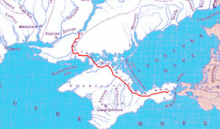
Based on the map published by the Consultative Group on International Agricultural Research (CGIAR),[120] the countries and regions suffering most water stress are North Africa, the Middle East,[121] India, Central Asia, China, Chile, Colombia, South Africa, Canada and Australia. Water scarcity is also increasing in South Asia.[122] As of 2016, about four billion people, or two-thirds of the world's population, were facing severe water scarcity.[123]
Generally speaking the more developed countries of North America, Europe and Russia will not see a serious threat to water supply by the year 2025, not only because of their relative wealth, but more importantly their populations will be better aligned with available water resources.[citation needed] North Africa, the Middle East, South Africa and northern China will face very severe water shortages due to physical scarcity and a condition of overpopulation relative to their carrying capacity with respect to water supply.[citation needed] Most of South America, Sub-Saharan Africa, Southern China and India will face water supply shortages by 2025; for these latter regions the causes of scarcity will be economic constraints to developing safe drinking water, as well as excessive population growth.[citation needed]
Africa
[edit]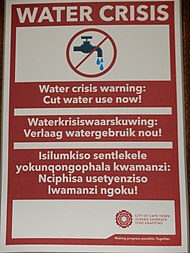
The main causes of water scarcity in Africa are physical and economic water scarcity, rapid population growth, and the effects of climate change on the water cycle. Water scarcity is the lack of fresh water resources to meet the standard water demand.[124] The rainfall in sub-Saharan Africa is highly seasonal and unevenly distributed, leading to frequent floods and droughts.[125]
The Food and Agriculture Organization of the United Nations reported in 2012 that growing water scarcity is now one of the leading challenges for sustainable development.[126] This is because an increasing number of river basins have reached conditions of water scarcity. The reasons for this are the combined demands of agriculture and other sectors. Water scarcity in Africa has several impacts. They range from health, particularly affecting women and children, to education, agricultural productivity and sustainable development. It can also lead to more water conflicts.
In response to the issue of unequal spatial resources key regions in South Africa have taken up the Market-Based practice of Water trading - Wikipedia.
West Africa and North Africa
[edit]Water scarcity in Yemen (see: Water supply and sanitation in Yemen) is a growing problem that has resulted from population growth, poor water management, climate change, shifts in rainfall, water infrastructure deterioration, poor governance, and other anthropogenic effects. As of 2011, it has been estimated that Yemen is experiencing water scarcity to a degree that affects its political, economic and social dimensions. As of 2015,[127] Yemen is among the most water scarce countries in the world. The majority of Yemen's population experiences water scarcity for at least one month during the year.
In Nigeria, some reports have suggested that increase in extreme heat, drought and the shrinking of Lake Chad is causing water shortage and environmental migration that is forcing thousands to migrate to neighboring Chad and towns.[128]
Asia
[edit]According to a major report compiled in 2019 by more than 200 researchers, the Himalayan glaciers that are the sources of Asia's biggest rivers – Ganges, Indus, Brahmaputra, Yangtze, Mekong, Salween and Yellow – could lose 66 percent of their ice by 2100.[129] Approximately 2.4 billion people live in the drainage basin of the Himalayan rivers.[130] India, China, Pakistan, Bangladesh, Nepal and Myanmar could experience floods followed by droughts in coming decades. In India alone, the Ganges provides water for drinking and farming for more than 500 million people.[131][132][133]
Even with the overpumping of its aquifers, China is developing a grain deficit. When this happens, it will almost certainly drive grain prices upward. Most of the 3 billion people projected to be added worldwide by mid-century will be born in countries already experiencing water shortages. Unless population growth can be slowed quickly, it is feared that there may not be a practical non-violent or humane solution to the emerging world water shortage.[134][135]
It is highly likely that climate change in Turkey will cause its southern river basins to be water scarce before 2070, and increasing drought in Turkey.[136]
Americas
[edit]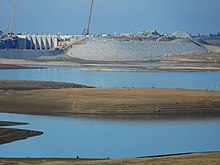
In the Rio Grande Valley, intensive agribusiness has exacerbated water scarcity issues and sparked jurisdictional disputes regarding water rights on both sides of the U.S.-Mexico border. Scholars, including Mexican political scientist Armand Peschard-Sverdrup, have argued that this tension has created the need for a re-developed strategic transnational water management.[138] Some have declared the disputes tantamount to a "war" over diminishing natural resources.[139][140]
The west coast of North America, which gets much of its water from glaciers in mountain ranges such as the Rocky Mountains and Sierra Nevada, also would be affected.[141][142]
Australia
[edit]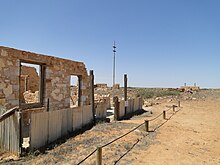
By far the largest part of Australia is desert or semi-arid lands commonly known as the outback.[143] Water restrictions are in place in many regions and cities of Australia in response to chronic shortages resulting from drought. The Australian of the year 2007, environmentalist Tim Flannery, predicted that unless it made drastic changes, Perth in Western Australia could become the world's first ghost metropolis, an abandoned city with no more water to sustain its population.[144] In 2010, Perth suffered its second-driest winter on record[145] and the water corporation tightened water restrictions for spring.[146]
Some countries have already proven that decoupling water use from economic growth is possible. For example, in Australia, water consumption declined by 40% between 2001 and 2009 while the economy grew by more than 30%.[93]
China
[edit]
In China there is a growing need for freshwater resources to perpetuate industrial development and to sustain a rapidly growing population. China is listed as the world's fourth largest country, harboring diverse environments across 9,596,960 square kilometers and hosting the largest population in the world (2021) backed by a growth rate of 0.26%.[147] China has invested in a network of Greywater pipes in order to maximize the usefulness industrial and residentially polluted water. Chinese territories are subject to the unbalanced spatial distribution of water resources and population density, the majority of both being situated in the southern and southeastern regions, respectively. The more mountainous northern reaches are less populated and are where the majority of industrial fuel operations occur, including mining, processing, combusting, washing and storing natural resources. In 2008, more than a quarter of Chinese aquatic resources per annum were being utilized to wash and process coal in the North[148]. Limited access to water in the industrial regions requires transferring water from the South of China to the energy plants in northern regions and results in significant conveyance loss[149]. Several Megaprojects have been launched in China with the goal of redirecting waterways and countering floods by building Reservoirs, Flood-Diversion-Zones, and Embankment Dams. Some of the more notorious and controversial examples of these undertakings include the Three Gorges Dam, and the South–North Water Transfer Project. Current efforts to minimize water waste involve improved coal-washing technologies, Agricultural and farmland consolidation efforts, however one downside to some of these massive countermeasures is an increase in Internally displaced persons (IDPs).
Society and culture
[edit]Global goals
[edit]
Sustainable Development Goal 6 is about "clean water and sanitation for all".[150] It is one of 17 Sustainable Development Goals established by the United Nations General Assembly in 2015. The fourth target of SDG 6 refers to water scarcity and states: "By 2030, substantially increase water-use efficiency across all sectors and ensure sustainable withdrawals and supply of freshwater to address water scarcity and substantially reduce the number of people suffering from water scarcity".[11] It has two indicators. The second one is: "Level of water stress: freshwater withdrawal as a proportion of available freshwater resources". The Food and Agriculture Organization of the United Nations (FAO) has been monitoring these parameters through its global water information system, AQUASTAT, since 1994.[31]: xii
See also
[edit]- Consumptive water use
- Peak water
- Water conservation
- Water footprint
- Water resources
- Water security
- All pages with titles containing water crisis
References
[edit]- ^ a b c d e f Rijsberman, Frank R. (2006). "Water scarcity: Fact or fiction?". Agricultural Water Management. 80 (1–3): 5–22. doi:10.1016/j.agwat.2005.07.001.
- ^ a b c d e IWMI (2007) Water for Food, Water for Life: A Comprehensive Assessment of Water Management in Agriculture. London: Earthscan, and Colombo: International Water Management Institute.
- ^ S. L. Postel, G. C. Daily, P. R. Ehrlich, Human appropriation of renewable fresh water. Science 271, 785–788 (1996).https://www.science.org/doi/10.1126/science.271.5250.785
- ^ H. H. G. Savenije, Water scarcity indicators; the deception of the numbers. Physics and Chemistry of the Earth B 25, 199–204 (2000).
- ^ a b c d e Mekonnen, Mesfin M.; Hoekstra, Arjen Y. (2016). "Four billion people facing severe water scarcity". Science Advances. 2 (2): e1500323. Bibcode:2016SciA....2E0323M. doi:10.1126/sciadv.1500323. ISSN 2375-2548. PMC 4758739. PMID 26933676.
- ^ a b c d e f g h Liu, Junguo; Yang, Hong; Gosling, Simon N.; Kummu, Matti; Flörke, Martina; Pfister, Stephan; Hanasaki, Naota; Wada, Yoshihide; Zhang, Xinxin; Zheng, Chunmiao; Alcamo, Joseph (2017). "Water scarcity assessments in the past, present, and future: REVIEW ON WATER SCARCITY ASSESSMENT". Earth's Future. 5 (6): 545–559. doi:10.1002/2016EF000518. PMC 6204262. PMID 30377623.
- ^ a b Vorosmarty, C. J. (14 July 2000). "Global Water Resources: Vulnerability from Climate Change and Population Growth". Science. 289 (5477): 284–288. Bibcode:2000Sci...289..284V. doi:10.1126/science.289.5477.284. PMID 10894773.
- ^ Ercin, A. Ertug; Hoekstra, Arjen Y. (2014). "Water footprint scenarios for 2050: A global analysis". Environment International. 64: 71–82. doi:10.1016/j.envint.2013.11.019. PMID 24374780.
- ^ a b c "Water Scarcity. Threats". WWF. 2013. Archived from the original on 21 October 2013. Retrieved 20 October 2013.
- ^ a b c d e f "Coping with water scarcity. An action framework for agriculture and food stress" (PDF). Food and Agriculture Organization of the United Nations. 2012. Archived (PDF) from the original on 4 March 2018. Retrieved 31 December 2017.
 Text was copied from this source, which is available under a Creative Commons Attribution 3.0 IGO (CC BY 3.0 IGO) license.
Text was copied from this source, which is available under a Creative Commons Attribution 3.0 IGO (CC BY 3.0 IGO) license.
- ^ a b c United Nations (2017) Resolution adopted by the General Assembly on 6 July 2017, Work of the Statistical Commission pertaining to the 2030 Agenda for Sustainable Development (A/RES/71/313)
- ^ a b c d "How do we prevent today's water crisis becoming tomorrow's catastrophe?". World Economic Forum. 23 March 2017. Archived from the original on 30 December 2017. Retrieved 30 December 2017.
- ^ a b c d e f The CEO Water Mandate (2014) Driving Harmonization of Water-Related Terminology, Discussion Paper September 2014. Alliance for Water Stewardship, Ceres, CDP (formerly the Carbon Disclosure Project), The Nature Conservancy, Pacific Institute, Water Footprint Network, World Resources Institute, and WWF
- ^ "Water Conflict Chronology". www.worldwater.org. Retrieved 17 November 2021.
- ^ a b Kummu, M.; Guillaume, J. H. A.; de Moel, H.; Eisner, S.; Flörke, M.; Porkka, M.; Siebert, S.; Veldkamp, T. I. E.; Ward, P. J. (2016). "The world's road to water scarcity: shortage and stress in the 20th century and pathways towards sustainability". Scientific Reports. 6 (1): 38495. doi:10.1038/srep38495. ISSN 2045-2322. PMC 5146931. PMID 27934888.
- ^ a b Bonnafous, Luc; Lall, Upmanu; Siegel, Jason (19 April 2017). "A water risk index for portfolio exposure to climatic extremes: conceptualization and an application to the mining industry". Hydrology and Earth System Sciences. 21 (4): 2075–2106. Bibcode:2017HESS...21.2075B. doi:10.5194/hess-21-2075-2017. ISSN 1607-7938.
- ^ a b "The Water Crisis and Industries at Risk". Morgan Stanley. Retrieved 6 April 2020.
- ^ Carr, Acacia (3 December 2018). "Water Risk: Single Largest Risk Threatening People, Planet and Profit | GreenMoney Journal". Retrieved 6 April 2020.
- ^ "Climate change is devastating the world's water supplies. Why aren't we talking about it?". Climate & Capital Media. 14 January 2021. Retrieved 15 January 2021.
- ^ "New Water Risk Filter Scenarios will help companies and investors turn risk into resilience".
{{cite web}}: CS1 maint: url-status (link) - ^ "Water risk gathers steam with moves from DWS, WWF and Thomas Schumann Capital". Responsible Investor. Retrieved 23 February 2021.
- ^ a b Sadoff, Claudia; Grey, David; Borgomeo, Edoardo (2020). "Water Security". Oxford Research Encyclopedia of Environmental Science. doi:10.1093/acrefore/9780199389414.013.609. ISBN 978-0-19-938941-4.
- ^ a b Grey, David; Sadoff, Claudia W. (1 December 2007). "Sink or Swim? Water security for growth and development". Water Policy. 9 (6): 545–571. doi:10.2166/wp.2007.021. hdl:11059/14247. ISSN 1366-7017.
- ^ REACH (2020) REACH Global Strategy 2020-2024, University of Oxford, Oxford, UK (REACH program).
- ^ a b c d United Nations Development Programme (2006). Human Development Report 2006: Beyond Scarcity–Power, Poverty and the Global Water Crisis Archived 7 January 2018 at the Wayback Machine. Basingstoke, United Kingdom:Palgrave Macmillan.
- ^ Molden, D. (Ed). Water for food, Water for life: A Comprehensive Assessment of Water Management in Agriculture. Earthscan/IWMI, 2007, p.11
- ^ Molden, David; Fraiture, Charlotte de; Rijsberman, Frank (1 January 1970). "Water Scarcity: The Food Factor". Issues in Science and Technology. Retrieved 22 September 2021.
- ^ Duchin, Faye; López-Morales, Carlos (December 2012). "Do Water-Rich Regions Have A Comparative Advantage In Food Production? Improving The Representation Of Water For Agriculture In Economic Models". Economic Systems Research. 24 (4): 371–389. doi:10.1080/09535314.2012.714746. S2CID 154723701.
- ^ a b c Madulu, Ndalahwa (2003). "Linking poverty levels to water resource use and conflicts in rural Tanzania". Physics & Chemistry of the Earth - Parts A/B/C. 28 (20–27): 911. Bibcode:2003PCE....28..911M. doi:10.1016/j.pce.2003.08.024.
- ^ Noemdoe, S.; Jonker, L.; Swatuk, L.A (2006). "Perceptions of water scarcity: The case of Genadendal and outstations". Physics and Chemistry of the Earth. 31 (15): 771–778. Bibcode:2006PCE....31..771N. doi:10.1016/j.pce.2006.08.003. hdl:11394/1905.
- ^ a b c FAO (2018). Progress on level of water stress - Global baseline for SDG 6 Indicator 6.4.2 Rome. FAO/UN-Water. 58 pp. Licence: CC BY-NC-SA 3.0 IGO.
- ^ a b Ritchie, Roser, Mispy, Ortiz-Ospina. "Measuring progress towards the Sustainable Development Goals." SDG-Tracker.org, website (2018)
- ^ Matlock, Marty D. "A Review of Water Scarcity Indices and Methodologies" (PDF). University of Arkansas - The Sustainability Consortium. Archived from the original (PDF) on 13 October 2017. Retrieved 5 February 2018.
- ^ Falkenmark, Malin; Lundqvist, Jan; Widstrand, Carl (1989). "Macro-scale water scarcity requires micro-scale approaches". Natural Resources Forum. 13 (4): 258–267. doi:10.1111/j.1477-8947.1989.tb00348.x. PMID 12317608.
- ^ a b c d e f g WWAP (World Water Assessment Programme). 2012. The United Nations World Water Development Report 4: Managing Water under Uncertainty and Risk. Paris, UNESCO.
- ^ "The Water Crisis and its solutions: We need to take global action now". WaterStillar. Retrieved 19 September 2021.
- ^ a b Conceição, Pedro (2020). "The next frontier Human development and the Anthropocene". United Nations Development Reports. Retrieved 14 March 2021.
- ^ "Global risks report 2019". World Economic Forum. Archived from the original on 25 March 2019. Retrieved 25 March 2019.
- ^ a b c Matti Kummu; Philip J Ward; Hans de Moel; Olli Varis (16 August 2010). "Is physical water scarcity a new phenomenon? Global assessment of water shortage over the last two millennia". Environmental Research Letters. 5 (3): 034006. Bibcode:2010ERL.....5c4006K. doi:10.1088/1748-9326/5/3/034006. ISSN 1748-9326.
- ^ Baer, Anne (June 1996). "Not enough water to go around". International Social Science Journal. 48 (148): 277–292. doi:10.1111/j.1468-2451.1996.tb00079.x – via Wiley Online Library.
- ^ Famiglietti, James S.; Ferguson, Grant (23 April 2021). "The hidden crisis beneath our feet". Science. 372 (6540): 344–345. Bibcode:2021Sci...372..344F. doi:10.1126/science.abh2867. PMID 33888627. S2CID 233353241. Retrieved 10 May 2021.
- ^ "The largest assessment of global groundwater wells finds many are at risk of drying up". ScienceDaily. Retrieved 10 May 2021.
- ^ Jasechko, Scott; Perrone, Debra (23 April 2021). "Global groundwater wells at risk of running dry". Science. 372 (6540): 418–421. Bibcode:2021Sci...372..418J. doi:10.1126/science.abc2755. ISSN 0036-8075. PMID 33888642. S2CID 233353207. Retrieved 10 May 2021.
- ^ Nouri, H.; Stokvis, B.; Galindo, A.; Blatchford, M.; Hoekstra, A.Y. (2019). "Water scarcity alleviation through water footprint reduction in agriculture: The effect of soil mulching and drip irrigation". Science of the Total Environment. 653: 241–252. Bibcode:2019ScTEn.653..241N. doi:10.1016/j.scitotenv.2018.10.311. PMID 30412869.
- ^ Barnes, Jessica (Fall 2020). "Water in the Middle East: A Primer" (PDF). Middle East Report. 296: 1–9. Archived (PDF) from the original on 27 November 2020. Retrieved 19 November 2020 – via Middle East Research and Information Project (MERIP).
- ^ Progress in Drinking-water and Sanitation: special focus on sanitation (PDF). WHO/UNICEF Joint Monitoring Programme for Water Supply and Sanitation. 17 July 2008. p. 25. Archived (PDF) from the original on 11 July 2018. Retrieved 19 November 2012.
{{cite book}}:|work=ignored (help) - ^ "Water is Life – Groundwater drawdown". Academic.evergreen.edu. Archived from the original on 16 June 2011. Retrieved 10 March 2011.
- ^ a b "The Coming Wars for Water". Report Syndication. 12 October 2019. Archived from the original on 19 October 2019. Retrieved 6 January 2020.
- ^ "Water Scarcity Index – Vital Water Graphics". Archived from the original on 16 December 2008. Retrieved 20 October 2013.
- ^ J.E. Lawrence; C.P.W. Pavia; S. Kaing; H.N. Bischel; R.G. Luthy; V.H. Resh (2014). "Recycled Water for Augmenting Urban Streams in Mediterranean-climate Regions: A Potential Approach for Riparian Ecosystem Enhancement". Hydrological Sciences Journal. 59 (3–4): 488–501. doi:10.1080/02626667.2013.818221. S2CID 129362661.
- ^ "Land Subsidence in the United States". water.usgs.gov. Retrieved 15 June 2021.
- ^ Water, a shared responsibility. The United Nations World Water Development Report 2 Archived 6 January 2009 at the Wayback Machine, 2006
- ^ Segerfeldt, Fredrik (25 August 2005), "Private Water Saves Lives" Archived 21 September 2011 at the Wayback Machine, Financial Times.
- ^ Zetland, David (1 August 2008) "Running Out of Water" Archived 7 July 2011 at the Wayback Machine. aguanomics.com
- ^ Zetland, David (14 July 2008) "Water Crisis" Archived 7 July 2011 at the Wayback Machine. aguanomics.com
- ^ "Why Water? - Water Changes Everything". Water.org. Retrieved 24 March 2020.
- ^ "Global Water Shortage: Water Scarcity & How to Help - Page 2". The Water Project. Retrieved 24 March 2020.
- ^ "Lake Chad: Can the vanishing lake be saved?". BBC News. 31 March 2018. Archived from the original on 9 August 2019. Retrieved 9 August 2019.
- ^ United Nations Press Release POP/952, 13 March 2007. World population will increase by 2.5 billion by 2050 Archived 28 July 2009 at the Wayback Machine
- ^ "World population to reach 9.1 billion in 2050, UN projects". Un.org. 24 February 2005. Archived from the original on 22 July 2017. Retrieved 12 March 2009.
- ^ Foster, S. S.; Chilton, P. J. (29 December 2003). "Groundwater – the processes and global significance of aquifer degradation". Philosophical Transactions of the Royal Society of London. Series B, Biological Sciences. 358 (1440): 1957–1972. doi:10.1098/rstb.2003.1380. PMC 1693287. PMID 14728791.
- ^ "Water". World Bank. Archived from the original on 26 April 2012. Retrieved 19 November 2012.
- ^ "Sustaining water for all in a changing climate: World Bank Group Implementation Progress Report". The World Bank. 2010. Archived from the original on 13 April 2012. Retrieved 24 October 2011.
- ^ "Europe's Environment: The Dobris Assessment". Reports.eea.europa.eu. 20 May 1995. Archived from the original on 22 September 2008. Retrieved 12 March 2009.
- ^ "Groundwater in Urban Development". Wds.worldbank.org. 31 March 1998. p. 1. Archived from the original on 16 October 2007. Retrieved 12 March 2009.
- ^ "Archived copy". unesdoc.unesco.org. Archived from the original on 21 October 2020. Retrieved 18 September 2020.
{{cite web}}: CS1 maint: archived copy as title (link) - ^ Giordano, M. and Volholth, K. (ed.) 2007. The Agricultural Groundwater Revolution. Wallingford, UK, Centre for Agricultural Bioscience International (CABI).
- ^ WWAP (World Water Assessment Programme). 2009. Water in a Changing World. World Water Development Report 3. Paris/London, UNESCO Publishing/Earthscan.
- ^ "What California can learn from Saudi Arabia's water mystery". Reveal. 22 April 2015. Archived from the original on 22 November 2015. Retrieved 9 August 2019.
- ^ Foster, S. and Loucks, D. 2006. Non-renewable Groundwater Resources. UNESCO-IHP Groundwater series No. 10. Paris, UNESCO.
- ^ "Why freshwater shortages will cause the next great global crisis". The Guardian. 8 March 2015. Archived from the original on 11 November 2019. Retrieved 3 January 2018.
- ^ "Water, bron van ontwikkeling, macht en conflict" (PDF). NCDO, Netherlands. 8 January 2012. Archived (PDF) from the original on 12 April 2019. Retrieved 1 January 2018.
- ^ Haie, Naim (2020). Transparent Water Management Theory: Sefficiency in Sequity (PDF). Springer.
- ^ Haie, Naim (2020). Transparent Water Management Theory: Sefficiency in Sequity (PDF). Springer.
- ^ Von Sperling, Marcos (2007). "Wastewater Characteristics, Treatment and Disposal". Water Intelligence Online. Biological Wastewater Treatment. 6. IWA Publishing. doi:10.2166/9781780402086. ISBN 978-1-78040-208-6.
- ^ Eckenfelder Jr WW (2000). Kirk-Othmer Encyclopedia of Chemical Technology. John Wiley & Sons. doi:10.1002/0471238961.1615121205031105.a01. ISBN 978-0-471-48494-3.
- ^ "Water Pollution". Environmental Health Education Program. Cambridge, MA: Harvard T.H. Chan School of Public Health. 23 July 2013. Archived from the original on 18 September 2021. Retrieved 18 September 2021.
- ^ Schaffner, Monika; Bader, Hans-Peter; Scheidegger, Ruth (15 August 2009). "Modeling the contribution of point sources and non-point sources to Thachin River water pollution". Science of the Total Environment. 407 (17): 4902–4915. doi:10.1016/j.scitotenv.2009.05.007. ISSN 0048-9697.
- ^ Moss B (February 2008). "Water pollution by agriculture". Philosophical Transactions of the Royal Society of London. Series B, Biological Sciences. 363 (1491): 659–666. doi:10.1098/rstb.2007.2176. PMC 2610176. PMID 17666391.
- ^ "Water and Climate Change: Understanding the Risks and Making Climate-Smart Investment Decisions". World Bank. 2009. Archived from the original on 7 April 2012. Retrieved 24 October 2011.
- ^ FAO Hot issues: Water scarcity Archived 25 October 2012 at the Wayback Machine. Fao.org. Retrieved on 27 August 2013.
- ^ The World Bank, 2009 "Water and Climate Change: Understanding the Risks and Making Climate-Smart Investment Decisions". pp. 21–24. Archived from the original on 7 April 2012. Retrieved 24 October 2011.
- ^ "GEO-2000 overview overview" (PDF). unep.org. Archived (PDF) from the original on 7 February 2017. Retrieved 22 September 2016.
- ^ a b Oerlemans, J (1998). "Modeling the response of glaciers to climate warming". Climate Dynamics. 14 (4): 267–274. Bibcode:1998ClDy...14..267O. doi:10.1007/s003820050222. S2CID 128464695.
- ^ Corrpio, J.G. (2004). "Snow surface albedo estimation using terrestrial photography". International Journal of Remote Sensing. 25:24 (24): 5705–5729. Bibcode:2004IJRS...25.5705C. doi:10.1080/01431160410001709002. S2CID 55830821 – via Google scholar.
- ^ Huss, Matthias; Hock, Regine (January 2018). "Global-scale hydrological response to future glacier mass loss". Nature Climate Change. 8 (2): 135–140. Bibcode:2018NatCC...8..135H. doi:10.1038/s41558-017-0049-x. S2CID 5025320.
- ^ "Water crisis looms as Himalayan glaciers retreat". wwf.panda.org. Archived from the original on 11 March 2021. Retrieved 7 November 2020.
- ^ Immerzeel, Walter W.; Beek, Ludovicus P. H. van; Bierkens, Marc F. P. (11 June 2010). "Climate Change Will Affect the Asian Water Towers". Science. 328 (5984): 1382–1385. Bibcode:2010Sci...328.1382I. doi:10.1126/science.1183188. ISSN 0036-8075. PMID 20538947. S2CID 128597220. Archived from the original on 20 March 2021. Retrieved 25 March 2021.
- ^ Miller, James D.; Immerzeel, Walter W.; Rees, Gwyn (November 2012). "Climate Change Impacts on Glacier Hydrology and River Discharge in the Hindu Kush–Himalayas". Mountain Research and Development. 32 (4): 461–467. doi:10.1659/MRD-JOURNAL-D-12-00027.1. ISSN 0276-4741.
- ^ Reinman, Suzanne L. (10 February 2012). "Intergovernmental Panel on Climate Change (IPCC)201280Intergovernmental Panel on Climate Change (IPCC). Geneva: World Meteorological Organization and United Nations Environment Programme Last visited October 2011. Gratis URL: www.ipcc.ch/". Reference Reviews. 26 (2): 41–42. doi:10.1108/09504121211205250. ISSN 0950-4125. Archived from the original on 30 March 2021. Retrieved 25 March 2021.
- ^ Wester, Philippus; Mishra, Arabinda; Mukherji, Aditi; Shrestha, Arun Bhakta, eds. (2019). The Hindu Kush Himalaya Assessment. Springer. doi:10.1007/978-3-319-92288-1. hdl:10023/17268. ISBN 978-3-319-92287-4. S2CID 199491088. Archived from the original on 9 March 2021. Retrieved 25 March 2021.
- ^ Anand, P. B. (2004). "The political economy of water scarcity and issues of inequality, entitlements and identities: A tale of two cases from southern India". International Journal of Technology Management and Sustainable Development. 3 (2): 115–132. doi:10.1386/ijtm.3.2.115/0. ISSN 1474-2748.
- ^ a b "Half the world to face severe water stress by 2030 unless water use is "decoupled" from economic growth, says International Resource Panel". UN Environment. 21 March 2016. Archived from the original on 6 March 2019. Retrieved 11 January 2018.
- ^ Walsh, Decian (9 February 2020). "For Thousands of Years, Egypt Controlled the Nile. A New Dam Threatens That". New York Times. Archived from the original on 10 February 2020.
- ^ "Are Egypt and Ethiopia heading for a water war?". The Week. 8 July 2020. Archived from the original on 18 July 2020. Retrieved 18 July 2020.
- ^ "Row over Africa's largest dam in danger of escalating, warn scientists". Nature. 15 July 2020. Archived from the original on 18 July 2020. Retrieved 18 July 2020.
- ^ "Convention on the Law of the Non-Navigational Uses of International Watercourses - Main Page". legal.un.org. Retrieved 17 November 2021.
- ^ "un-water-is-a-human-right-aug-3-2010". Human Rights Documents online. Retrieved 17 November 2021.
- ^ "Measures to reduce personal water use - Defra - Citizen Space". consult.defra.gov.uk. Retrieved 13 September 2021.
- ^ "Cases in Water Conservation: How Efficiency Programs Help Water Utilities Save Water and Avoid Costs". EPA.gov. US Environmental Protection Agency.
- ^ Duane D. Baumann; John J. Boland; John H. Sims (April 1984). "Water Conservation: The Struggle over Definition". Water Resources Research. 20 (4): 428–434. Bibcode:1984WRR....20..428B. doi:10.1029/WR020i004p00428.
- ^ Vickers, Amy (2002). Water Use and Conservation. Amherst, MA: water plow Press. p. 434. ISBN 978-1-931579-07-0.
- ^ Geerts, Sam; Raes, Dirk (2009). "Review: Deficit irrigation as an on-farm strategy to maximize crop water productivity in dry areas". Agricultural Water Management. 96 (9): 1275–1284. Bibcode:2009AgWM...96.1275G. doi:10.1016/j.agwat.2009.04.009.
- ^ Shafeian, Nafise; Ranjbar, A.A.; Gorji, Tahereh B. (June 2022). "Progress in atmospheric water generation systems: A review". Renewable and Sustainable Energy Reviews. 161: 112325. doi:10.1016/j.rser.2022.112325. S2CID 247689027.
- ^ Jarimi, Hasila; Powell, Richard; Riffat, Saffa (18 May 2020). "Review of sustainable methods for atmospheric water harvesting". International Journal of Low-Carbon Technologies. 15 (2): 253–276. doi:10.1093/ijlct/ctz072.
- ^ Raveesh, G.; Goyal, R.; Tyagi, S.K. (July 2021). "Advances in atmospheric water generation technologies". Energy Conversion and Management. 239: 114226. Bibcode:2021ECM...23914226R. doi:10.1016/j.enconman.2021.114226. S2CID 236264708.
- ^ van Vliet, Michelle T H; Jones, Edward R; Flörke, Martina; Franssen, Wietse H P; Hanasaki, Naota; Wada, Yoshihide; Yearsley, John R (1 February 2021). "Global water scarcity including surface water quality and expansions of clean water technologies". Environmental Research Letters. 16 (2): 024020. Bibcode:2021ERL....16b4020V. doi:10.1088/1748-9326/abbfc3. ISSN 1748-9326.
- ^ Tuser, Cristina (24 May 2022). "What is potable reuse?". Wastewater Digest. Retrieved 29 August 2022.
- ^ Andersson, K., Rosemarin, A., Lamizana, B., Kvarnström, E., McConville, J., Seidu, R., Dickin, S. and Trimmer, C. (2016). Sanitation, Wastewater Management and Sustainability: from Waste Disposal to Resource Recovery. Nairobi and Stockholm: United Nations Environment Programme and Stockholm Environment Institute. ISBN 978-92-807-3488-1
- ^ "wastewater treatment | Process, History, Importance, Systems, & Technologies". Encyclopedia Britannica. 29 October 2020. Retrieved 4 November 2020.
- ^ "Desalination" (definition), The American Heritage Science Dictionary, via dictionary.com. Retrieved August 19, 2007.
- ^ Panagopoulos, Argyris; Haralambous, Katherine-Joanne; Loizidou, Maria (25 November 2019). "Desalination brine disposal methods and treatment technologies – A review". The Science of the Total Environment. 693: 133545. Bibcode:2019ScTEn.69333545P. doi:10.1016/j.scitotenv.2019.07.351. ISSN 1879-1026. PMID 31374511. S2CID 199387639.
- ^ Fischetti, Mark (September 2007). "Fresh from the Sea". Scientific American. 297 (3): 118–119. Bibcode:2007SciAm.297c.118F. doi:10.1038/scientificamerican0907-118. PMID 17784633.
- ^ Hoekstra, A. Y. (2003). Virtual water trade : proceedings of the international expert meeting on virtual water trade. IHE. OCLC 66727970.
- ^ Yang, Hong; Reichert, Peter; Abbaspour, Karim C.; Zehnder, Alexander J. B. (2003). "A Water Resources Threshold and Its Implications for Food Security". Environmental Science & Technology. 37 (14): 3048–3054. doi:10.1021/es0263689. ISSN 0013-936X. PMID 12901649.
- ^ Nicholson, Simon (2001). Water scarcity, conflict, and international water law: An examination of the regime established by the UN Convention on International Watercourses. New Zealand Journal of Environmental Law 5, (91).
- ^ Matchaya, G., Nhamo, L., Nhlengethwa, S., & Nhemachena, C., G, L, S, C. (2019). An Overview of Water Markets in Southern Africa: An Option for Water Management in Times of Scarcity. [Journal] Water, 11(5).
{{cite book}}: CS1 maint: multiple names: authors list (link) - ^ Oyedotun, Temitope D. Timothy; Ally, Nasrudeen (1 April 2021). "Environmental issues and challenges confronting surface waters in South America: A review". Environmental Challenges. 3: 100049. doi:10.1016/j.envc.2021.100049. ISSN 2667-0100.
- ^ "Pray For Rain: Crimea's Dry-Up A Headache For Moscow, Dilemma For Kyiv". Radio Free Europe/Radio Liberty. 29 March 2020. Archived from the original on 27 February 2021. Retrieved 14 February 2021.
- ^ "Retrieved 2009-01-19". Archived from the original on 8 July 2007.
- ^ Jameel M. Zayed, No Peace Without Water – The Role of Hydropolitics in the Israel-Palestine Conflict http://www.jnews.org.uk/commentary/“no-peace-without-water”-–-the-role-of-hydropolitics-in-the-israel-palestine-conflict
- ^ World Bank Climate Change Water: South Asia’s Lifeline at Risk, World Bank Washington D.C
- ^ Mekonnen, Mesfin M.; Hoekstra, Arjen Y. (2016). "Four billion people facing severe water scarcity". Science Advances. 2 (2): e1500323. Bibcode:2016SciA....2E0323M. doi:10.1126/sciadv.1500323. PMC 4758739. PMID 26933676.
- ^ "Water Scarcity | Threats | WWF". World Wildlife Fund. Retrieved 29 November 2020.
- ^ "International Decade for Action: Water for Life 2005-2015". Retrieved 1 April 2013.
- ^ FAO (2012). Coping with water scarcity - An action framework for agriculture and food security, FAO Rome.
- ^ "Running out of water: Conflict and water scarcity in Yemen and Syria". Atlantic Council. 12 September 2017. Archived from the original on 8 August 2020. Retrieved 24 February 2021.
- ^ "The Carbon Brief Profile: Nigeria". 21 August 2020. Archived from the original on 2 December 2020. Retrieved 30 November 2020.
- ^ "Himalayan glaciers melting at alarming rate, spy satellites show". National Geographic. 19 June 2019. Archived from the original on 18 July 2020. Retrieved 18 July 2020.
- ^ Big melt threatens millions, says UN. peopleandplanet.net. 4 June 2007
- ^ "Ganges, Indus may not survive: climatologists". Rediff.com. 31 December 2004. Archived from the original on 11 October 2017. Retrieved 10 March 2011.
- ^ "Glaciers melting at alarming speed". English.peopledaily.com.cn. 24 July 2007. Archived from the original on 25 December 2018. Retrieved 10 March 2011.
- ^ Singh, Navin (10 November 2004). "Himalaya glaciers melt unnoticed". BBC News. Archived from the original on 25 February 2020. Retrieved 10 March 2011.
- ^ Brown, Lester R. (27 September 2006). "Water Scarcity Crossing National Borders". Earth Policy Institute. Archived from the original on 31 March 2009. Retrieved 10 March 2011.
- ^ Brown, Lester R. (8 September 2002) Water Shortages May Cause Food Shortages. Greatlakesdirectory.org. Retrieved on 27 August 2013.
- ^ "Climate". climatechangeinturkey.com. Archived from the original on 22 October 2020. Retrieved 19 February 2021.
- ^ Alexander, Kurtis (19 May 2015). "California drought: People support water conservation, in theory". SF Gate. Archived from the original on 24 August 2020. Retrieved 18 July 2020.
- ^ Peschard-Sverdrup, Armand (7 January 2003). U.S.-Mexico Transboundary Water Management: The Case of the Rio Grande/Rio Bravo (1 ed.). Center for Strategic & International Studies. ISBN 978-0892064243.
- ^ Yardley, Jim (19 April 2002). "Water Rights War Rages on Faltering Rio Grande". The New York Times. Archived from the original on 13 September 2020. Retrieved 5 April 2020.
- ^ Guido, Zack. "Drought on the Rio Grande". Climate.gov. National Oceanic and Atmospheric Administration. Archived from the original on 22 February 2020. Retrieved 5 April 2020.
- ^ "Glaciers Are Melting Faster Than Expected, UN Reports". Sciencedaily.com. 18 March 2008. Archived from the original on 15 October 2019. Retrieved 10 March 2011.
- ^ Schoch, Deborah (2 May 2008) Water shortage worst in decades, official says Archived 7 October 2008 at the Wayback Machine, Los Angeles Times.
- ^ "'A Harbinger of Things to Come': Farmers in Australia Struggle With Its Hottest Drought Ever". Time. 21 February 2019. Archived from the original on 1 August 2020. Retrieved 18 July 2020.
- ^ Ayre, Maggie (3 May 2007). "Metropolis strives to meet its thirst". BBC News. Archived from the original on 17 July 2018. Retrieved 2 December 2011.
- ^ Waring, Karen (31 August 2010). "More winter blues as rainfall dries up". ABC News. Archived from the original on 12 May 2013. Retrieved 13 January 2011.
- ^ "Saving water in spring". Water corporation (Western Australia). 23 September 2010. Archived from the original on 23 February 2011. Retrieved 13 January 2011.
- ^ "Area - The World Factbook". www.cia.gov. Retrieved 7 December 2021.
- ^ Schneider, Keith; Turner, Jennifer L.; Jaffe, Aaron; Ivanova, Nadya (2011). "Choke Point China: Confronting Water Scarcity and Energy Demand in the World's Largest Country". Vermont Journal of Environmental Law. 12 (3): 713. ISSN 1936-4253. JSTOR vermjenvilaw.12.3.713.
- ^ "Dictionary of Water Terms". www.usgs.gov. Retrieved 7 December 2021.
- ^ "Goal 6: Clean water and sanitation". UNDP. Archived from the original on 9 April 2020. Retrieved 28 September 2015.
External links
[edit]Additional Resources
[edit]- Can Australia overcome its water scarcity problems? (n.d.). Retrieved November 8, 2021, from https://www.wentworthgroup.org/docs/Chartres_&_Williams.pdf.
- Eckstein, G. (n.d.). Water scarcity, conflict, and security in a climate change world: Challenges and opportunities for international law and policy. Texas A&M Law Scholarship. Retrieved November 8, 2021, from https://scholarship.law.tamu.edu/facscholar/333/.
- Green, B. E. (n.d.). Water Scarcity and International Conflict: An Analysis of Demographic, Development, Ecological, and Geo-Political Factors.
- Hutchings, C. (1997). Down to the Last Drop. Geographical (Companion Interactive Publishing), 69(8).
- Kwasniak, A. J. (2008). INTERNATIONAL PERSPECTIVES WATER SCARCITY AND AQUATIC SUSTAINABILITY: MOVING BEYOND POLICY LIMITATIONS.
- Lewis, S. T. (n.d.). Domestic solutions to the international problem of water ... Retrieved November 8, 2021, from https://digitalcommons.law.uga.edu/cgi/viewcontent.cgi?referer=&httpsredir=1&article=1100&context=gjicl.
- Matchaya, G., Nhamo, L., Nhlengethwa, S., & Nhemachena, C. (2019). An overview of water markets in Southern Africa: An option for water management in times of scarcity. Water, 11(5), 1006. https://doi.org/10.3390/w11051006
- Nicholson, S. (2001). Water Scarcity, Conflict, and International Water Law: An Examination of the Regime Established by the UN Convention on International Watercourses. New Zealand Journal of Environmental Law, 5(91).
- Oyedotun, T. D., & Ally, N. (2021). Environmental issues and challenges confronting surface waters in South America: A Review. Environmental Challenges, 3, 100049. https://doi.org/10.1016/j.envc.2021.100049
- Responding to water scarcity in western Canada. (n.d.). Retrieved November 8, 2021, from http://www.cba.org/cba/cle/PDF/ENV11_Percy_Paper.pdf.
- Schneider, K., Turner, J. L., Jaffe, A., & Ivanova, N. (2011). Choke point China: Confronting water scarcity and energy demand in the world's largest country. Vermont Journal of Environmental Law, 12(3), 713. https://doi.org/10.2307/vermjenvilaw.12.3.713
- Tularam, G. A., & Marchisella, P. (2013). Water scarcity in Asia and its long-term water and border security implications for Australia. Securing Water and Wastewater Systems, 189–211. https://doi.org/10.1007/978-3-319-01092-2_9
Indexes & Advanced References
[edit]- · ABOUT USGCRP. GlobalChange.gov. (n.d.). Retrieved November 9, 2021, from https://www.globalchange.gov/about.
- · Canada & united states border: International Boundary Commission. Canada & United States Border | International Boundary Commission. (n.d.). Retrieved November 9, 2021, from https://www.internationalboundarycommission.org/en/.
- · Central Intelligence Agency. (n.d.). Central Intelligence Agency. Retrieved November 9, 2021, from https://www.cia.gov/the-world-factbook/.
- · The codebook of the conflict and Peace Data Bank (COPDAB). CiteSeerX. (n.d.). Retrieved November 9, 2021, from http://citeseerx.ist.psu.edu/showciting?cid=2248926.
- · Corruption perceptions index 2020 for New Zealand. Transparency.org. (n.d.). Retrieved November 9, 2021, from https://www.transparency.org/en/cpi/2020/index/nzl.
- · Council on Foreign Relations. (n.d.). Global conflict tracker L council on foreign relations. Council on Foreign Relations. Retrieved November 9, 2021, from https://www.cfr.org/global-conflict-tracker/?category=us.
- · Data Catalog. About - International Boundary & Water Commission - Organizations - CKAN. (n.d.). Retrieved November 9, 2021, from https://catalog.data.gov/organization/about/ibwc-gov.
- · Water conflict chronology timeline list. (n.d.). Retrieved November 11, 2021, from http://www.worldwater.org/conflict/list/.
- · Data. USAFacts. (2020, January 20). Retrieved November 9, 2021, from https://usafacts.org/data/?utm_source=bing&utm_medium=cpc&utm_campaign=ND-StatsData&msclkid=2e2cb634bfce1f56bba0d7be3ab9dd46.
- · Environmental Protection Agency. (n.d.). EPA. Retrieved November 9, 2021, from https://www.epa.gov/.
- · Faostat. (n.d.). Retrieved November 9, 2021, from https://www.fao.org/faostat/en/#home.
- · The fund for peace. Fragile States Index. (n.d.). Retrieved November 9, 2021, from https://fragilestatesindex.org/.
- · California-Great Basin, B. of R. (n.d.). Central California Area Office. Water Facts - Worldwide Water Supply | ARWEC| CCAO | Area Offices | California-Great Basin | Bureau of Reclamation. Retrieved November 16, 2021, from https://www.usbr.gov/mp/arwec/water-facts-ww-water-sup.html.
- · Global corruption index 2021. Global Corruption ESG Indexes. (n.d.). Retrieved November 9, 2021, from https://risk-indexes.com/global-corruption-index/.
- · Global Environment Facility | UNEP - UN environment programme. (n.d.). Retrieved November 9, 2021, from https://www.unep.org/about-un-environment/funding-and-partnerships/global-environment-facility.
- · Global Environment Facility. (n.d.). Retrieved November 9, 2021, from https://www.thegef.org/.
- · Home Page. International Water Management Institute (IWMI). (2021, October 28). Retrieved November 9, 2021, from https://www.iwmi.cgiar.org/.
- · Home. World's Water. (2020, September 28). Retrieved November 9, 2021, from https://www.worldwater.org/.
- · Home: International court of justice. Home | International Court of Justice. (n.d.). Retrieved November 9, 2021, from https://www.icj-cij.org/en.
- · Human development reports. Human Development Index (HDI) | Human Development Reports. (n.d.). Retrieved November 9, 2021, from http://hdr.undp.org/en/content/human-development-index-hdi.
- · Iladmin. (n.d.). International Law Association. Demo. Retrieved November 9, 2021, from https://www.ila-hq.org/.
- · The Intergovernmental Panel on Climate Change. IPCC. (n.d.). Retrieved November 9, 2021, from https://www.ipcc.ch/.
- · International Monetary Fund - Homepage. IMF. (n.d.). Retrieved November 9, 2021, from https://www.imf.org/en/home.
- · NASA. (n.d.). Climate change: Vital signs of the planet. NASA. Retrieved November 9, 2021, from https://climate.nasa.gov/.
- · Prices. Food and Agriculture Organization of the United Nations. (n.d.). Retrieved November 9, 2021, from https://www.fao.org/prices/en/.
- · Program in water conflict management and transformation. Transboundary Freshwater Dispute Database | Program in Water Conflict Management and Transformation | Oregon State University. (n.d.). Retrieved November 9, 2021, from https://transboundarywaters.science.oregonstate.edu/content/transboundary-freshwater-dispute-database.
- · Real Time World Statistics. Worldometer. (n.d.). Retrieved November 9, 2021, from https://www.worldometers.info/.
- · Ritchie, H., & Roser, M. (2017, November 20). Water use and stress. Our World in Data. Retrieved November 9, 2021, from https://ourworldindata.org/water-use-stress.
- · Statistical Data. National Bureau of Statistics of China. (n.d.). Retrieved November 9, 2021, from http://www.stats.gov.cn/enGliSH/.
- · Team, P. S. L. W. (n.d.). Extended multivariate enso index (mei.ext). PSL. Retrieved November 9, 2021, from https://psl.noaa.gov/enso/mei.ext/.
- · Together we make water a global priority. Home | World Water Council. (n.d.). Retrieved November 9, 2021, from https://www.worldwatercouncil.org/en.
- · Transboundary freshwater dispute database. (n.d.). Retrieved November 9, 2021, from http://gis.nacse.org/tfdd/index.php.
- · U.S. Geological Survey. USGS.gov | Science for a changing world. (n.d.). Retrieved November 9, 2021, from https://www.usgs.gov/.
- · United Nations Development Programme. UNDP. (2021, August 11). Retrieved November 9, 2021, from https://www.undp.org/.
- · UNEP - UN environment programme. (n.d.). Retrieved November 11, 2021, from https://www.unep.org/.
- · United Nations. (n.d.). International law, codification, legal affairs, commission, ILC, instruments and reports, yearbook. United Nations. Retrieved November 9, 2021, from https://legal.un.org/ilc/.
- · United Nations. (n.d.). Permanent sovereignty over Natural Resources, General Assembly resolution 1803 (XVII) - main page. United Nations. Retrieved November 9, 2021, from https://legal.un.org/avl/ha/ga_1803/ga_1803.html.
- · Water scarcity index: Grid-Arendal. GRID. (n.d.). Retrieved November 9, 2021, from https://www.grida.no/resources/5586.
- · Water: Coordinating the UN's work on water and sanitation. UN. (n.d.). Retrieved November 9, 2021, from https://www.unwater.org/.
- · World Bank Group - International Development, Poverty, & Sustainability. World Bank. (n.d.). Retrieved November 9, 2021, from https://www.worldbank.org/en/home.
- · World development indicators. DataBank. (n.d.). Retrieved November 9, 2021, from https://databank.worldbank.org/reports.aspx?source=world-development-indicators.
- · The World Economic Forum. World Economic Forum. (n.d.). Retrieved November 9, 2021, from https://www.weforum.org/.
- · World Health Organization. (n.d.). Home. World Health Organization. Retrieved November 9, 2021, from https://www.who.int/.
- · World Water Assessment Programme. UNESCO. (2021, October 28). Retrieved November 9, 2021, from https://en.unesco.org/wwap.
- · Worldwatch Institute. Common Dreams. (2021, May 29). Retrieved November 9, 2021, from https://www.commondreams.org/organization/worldwatch-institute.
- · Convention on the law of non-navigational ... - united nations. (n.d.). Retrieved November 9, 2021, from https://legal.un.org/ilc/texts/instruments/english/conventions/8_3_1997.pdf.
- · A/RES/64/292 - e - A/RES/64/292 -desktop. (n.d.). Retrieved November 9, 2021, from https://undocs.org/A/RES/64/292.
- · World Trade Organization - Global Trade. World Trade Organization - Home page - Global trade. (n.d.). Retrieved November 9, 2021, from https://www.wto.org/.
- · Understanding supply-side and demand-side to support water management in the Asia Pacific: Australian water partnership. Australian Water Partnership | Australia – water partners for development. (2019, August 6). Retrieved November 11, 2021, from https://waterpartnership.org.au/understanding-supply-side-and-demand-side-to-support-water-management-in-the-asia-pacific/.
- · Water scarcity issues: We're running out of water. FEW Resources.org. (n.d.). Retrieved November 11, 2021, from https://www.fewresources.org/water-scarcity-issues-were-running-out-of-water.html.
- · Instream Flow Council. INSTREAM FLOW COUNCIL. (n.d.). Retrieved November 11, 2021, from https://www.instreamflowcouncil.org/faq/.
- · Environmental performance index. EPI. (n.d.). Retrieved November 11, 2021, from https://epi.yale.edu/epi-results/2020/component/epi.
- · Wright, M. (2019, October 21). Most water-stressed countries in the world for 2019. CEOWORLD magazine. Retrieved November 11, 2021, from https://ceoworld.biz/2019/08/08/most-water-stressed-countries-in-the-world-for-2019/.
- · Baranyai, G. (1970, January 1). European Water Law and Hydropolitics: An inquiry into the resilience of transboundary water governance in the European Union: Semantic scholar. undefined. Retrieved November 11, 2021, from https://www.semanticscholar.org/paper/European-Water-Law-and-Hydropolitics%3A-An-Inquiry-of-Baranyai/2eaa449952b4ce5da987bb31917a5496d1ee4c50.
- · U.S. Agency for International Development. (n.d.). Retrieved November 11, 2021, from https://www.usaid.gov/.
- · National Blue Ribbon Commission for onsite non-potable Water Systems. National Blue Ribbon Commission for Onsite Non-potable Water Systems | US Water Alliance. (n.d.). Retrieved November 11, 2021, from http://uswateralliance.org/initiatives/commission.
- · Nag, O. S. (2019, July 16). The largest lakes by volume in each continent. WorldAtlas. Retrieved November 11, 2021, from https://www.worldatlas.com/articles/the-largest-lakes-by-volume-in-each-continent.html.
- · World Resources Institute: Making big ideas happen. World Resources Institute | Making Big Ideas Happen. (2021, November 6). Retrieved November 11, 2021, from https://www.wri.org/.
- · WorldRichestCountries.com. World's Richest Countries. (n.d.). Retrieved November 12, 2021, from http://www.worldsrichestcountries.com/index.html.
- · .nl, R. W. (n.d.). Populair countries. World Country, all the 247 countries of the World. Retrieved November 14, 2021, from http://www.world-country.com/.
- · Global annual average climate moisture index (CMI). Global Annual Average Climate Moisture Index (CMI) | Data Basin. (n.d.). Retrieved November 14, 2021, from https://databasin.org/datasets/65a60b2ba42b4a9281e915a8585be8ec/.
- · Types of water pollution. Sciencetopia. (2021, January 20). Retrieved November 16, 2021, from https://www.sciencetopia.net/pollution/water/types.

